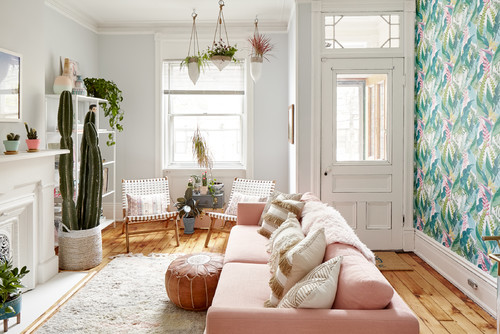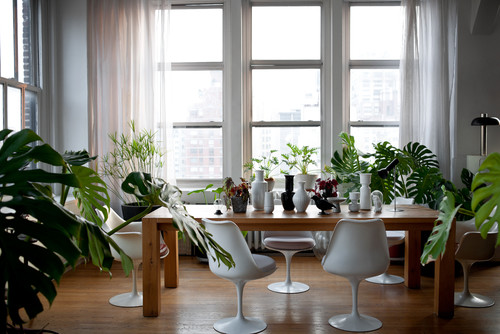
ablokhin/Getty Images
Now that we’re all spending more time at home, it’s no surprise that some of us have picked up new hobbies. After all, you can only take in so much Netflix before you start to get restless. And there’s a good chance one of those hobbies has something to do with plants.
Pandemic plant parents are definitely a thing, and there are more of us out there than you think.
For that reason, your local nurseries, garden supply stores, and even hardware stores may be running low on supplies. If that’s the case, it may be time to move your plant search online.
But buying plants online is a lot different from choosing them in person. If you don’t know exactly what you’re doing, it can lead to disaster.
But we’re not going to leave you (or your future plants) hanging out to dry. Here’s what you should avoid doing when buying plants online—and what you should be doing instead.
1. Buying a plant that’s wrong for your space

Photo by A.Jennison Interiors
You’ve drooled over enough plants on Instagram to know exactly which plant you need to complete your home. But does that plant actually work in the space that you have? Unless you do your homework, you may be bringing home a plant that’s going to die.
“Every plant will have its own natural preferences in terms of light, ambient temperature, humidity, watering needs, and feeding requirements,” says Andrew Gaumond, horticulturist, botanist, and director of content at Petal Republic.
“It’s imperative that you’re able to replicate these conditions to the best of your ability in your home environment, in order to give your new houseplant the best chance of thriving.”
Gaumond says most plant websites will allow you to filter your search by the type of environment you can offer. Taking advantage of those features will ensure a happier life for both you and your plants.
2. Not reading up on plant maintenance
Some of us are low-maintenance, while others need a little more attention—and the same can be said for members of the plant world.
“It’s important to consider how much time you have available and are prepared to invest in ensuring your new houseplant thrives in your home,” says Gaumond.
“If you’re likely to be away a lot, or not looking for such a serious relationship, look for something super easy to care for that will tolerate all kinds of neglect, such as the ZZ plant (the Zanzibar Gem or Zamioculcas zamiifolia), Dracaena giganta, Pothos jade, or even an aloe plant.”
3. Misjudging the plant’s real size

Photo by Michelle Gage | Interior Designer
You’re clicking through a plant seller’s options, and you spot a tall, full-looking plant that’s what you’ve been looking for.
Slow down and read before you click “Add to cart,” because that may not be what’s actually for sale.
You may be purchasing a cutting of that plant, or a plant that could potentially grow to that size.
Deborah Choi, founder of horticure.com, says this happens more than you might think.
“Carefully check the plant height and pot diameter details. This will ensure that you’re getting what you paid for and help you determine if it’s the right size plant for your space,” she says.
“Keep in mind, too, that often, the plant height is measured from the bottom of the planter or grow pot to the tallest leaf, as opposed to measuring from the top of the soil.”
It’s definitely a bummer to open a box and find a plant that’s much smaller than you expected. Save yourself the disappointment by reading the fine print.
4. Not knowing how your plant will grow
Photo by Kristina Crestin Design
Now that you’re sure about what size plant you’re getting, it’s important to find out how much it will grow—especially if you’re dealing with limited space.
“Each will have their own varying natural growth rates, so try to have some foresight into where you’re planning to position your new houseplant and how much space you have available for the plant to mature,” says Gaumond.
“Monstera deliciosa, for instance, has a habit of growing up, as well as out, at a pretty decent rate [up to 70 centimeters a year], and the very popular fiddle-leaf fig can reach as high as 10 feet tall indoors.”
If you don’t have a room with cathedral ceilings, stick with a plant that will stay a more manageable size.
5. Not reading reviews
By the time you’ve looked at the pictures and read about how easy that gorgeous plant is to care for, you’re pretty much sold.
But have you skimmed the reviews at the bottom of the page?
Tina Huffman, horticulturalist and landscape designer from Greenhouse Studio, says this is a frequent—and unfortunate—omission. She says it’s important to find out if the seller’s past customers have been happy.
“How have the reviews stated their plants arrived? Were they carefully packaged and in good shape?” she asks.
“No point in paying for a mature-size plant if the best branch, leaf, or growing point has snapped off on arrival, or it’s desiccated or damaged from cold.”
With the widely reported delays in postal service, you may want to check recent reviews regarding shipping, and whether the company uses UPS or FedEx for delivery, rather than the U.S. Postal Service.
6. Not watching the weather
The convenience of ordering plants online will mean that someone actually brings them right to your door. But it’s important to remember that most plants are pretty fragile, and they have to go through a lot to get to you.
Susan Brandt, founder and president of Blooming Secrets, says buyers often don’t take their local temperature into account when clicking “Add to cart” on that plant they’ve been eyeing.
A popular plant-buying mistake is purchasing a plant when it’s too cold, she says.
“If the temperatures are freezing, be careful. This can cause stress on the plant, and your plant will freeze or die.”
The same goes for extremely hot temperatures, say the experts at Bloomscapes, who claim they take care to package plants in a way that protects them from the elements as much as possible.
Still, they warn that when ordering plants during extreme temperatures, it’s best to bring them inside as soon as they arrive on your doorstep.
7. Not checking the return policy
If you’ve purchased plants at your local greenhouse, you probably know that you have ample time to return that plant if something goes wrong—even if that “something” is your forgetting it in your trunk for a day or two.
But, according to Gregory Birch, of Gardens of Bacchus, the same is not usually true when you’re buying plants online.
“When you buy a plant in store, and it dies, you drive it back to the store and they give you a new one. The retailer then loses the cost of the replacement plant, which is maybe a few bucks,” he explains.
“When you order a plant online and it dies, they have to ship you another one. They then lose the cost of the replacement plant, the packaging, and the shipping cost.”
Birch says online warranties are usually around 30 days, but may be as short as five or less.
“Make sure to check this before you buy!” he warns.
The post Buying Plants Online? Don’t Make These 7 Harmful Mistakes appeared first on Real Estate News & Insights | realtor.com®.





This comment has been removed by the author.
ReplyDelete
ReplyDeletehigh quality furniture retailer online - furnitureretro.com
Very efficiently written information. It will be beneficial to anybody who utilizes it, including me. Keep up the good work. For sure i will check out more posts. This site seems to get a good amount of visitors. vendita piante online
ReplyDelete